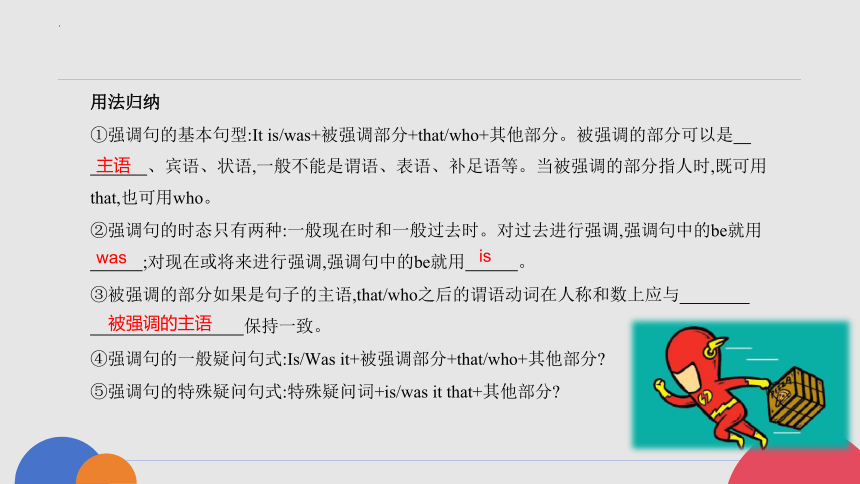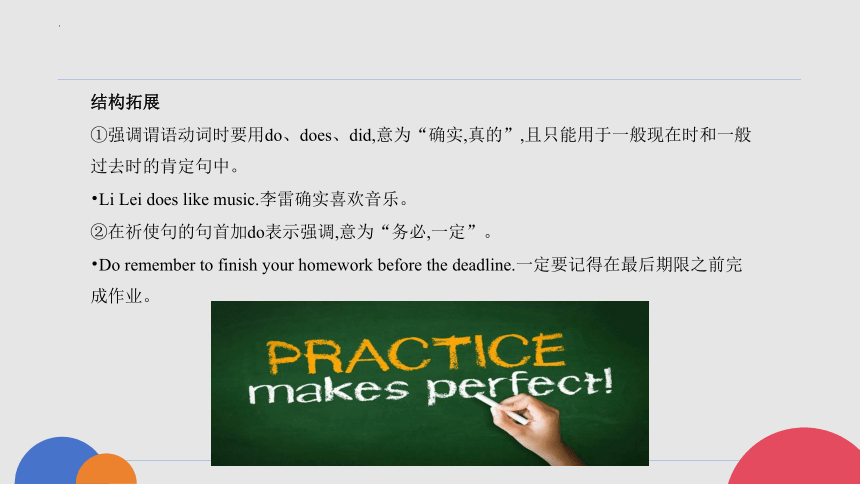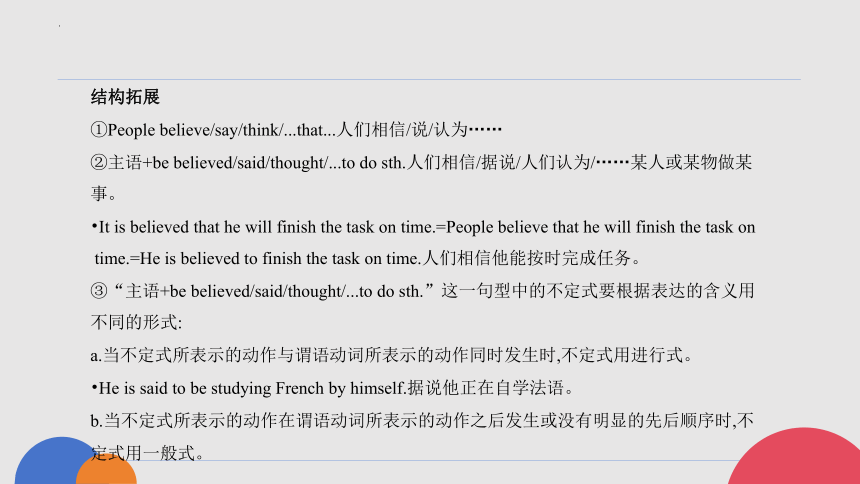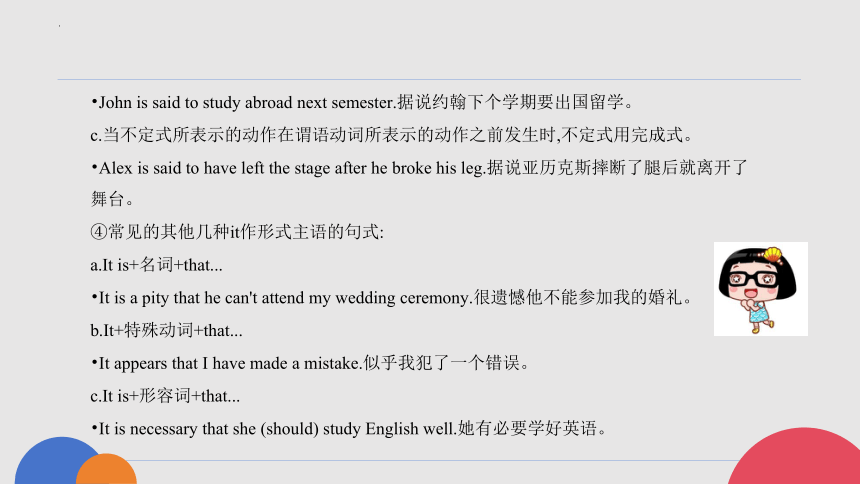北师大版(2019) 选择性必修第三册Unit 7 Careers 语法知识复习课件(共27张PPT)
文档属性
| 名称 | 北师大版(2019) 选择性必修第三册Unit 7 Careers 语法知识复习课件(共27张PPT) |  | |
| 格式 | pptx | ||
| 文件大小 | 2.3MB | ||
| 资源类型 | 教案 | ||
| 版本资源 | 北师大版(2019) | ||
| 科目 | 英语 | ||
| 更新时间 | 2024-04-12 21:37:45 | ||
图片预览









文档简介
(共27张PPT)
Unit 7 语法知识精讲
It is/was+被强调部分+that+其他部分
...it is IQ that gets you employed, but it is EQ that gets you promoted.……是智商让你就业,但
是情商让你升职。
情景导学
It was in this house that I was born.我正是在这个房子里出生的。
It is the fitness level of our body that helps us fight these diseases.正是我们身体的健康水平帮
助我们对抗这些疾病。
It was an old magazine that Mary found in the bag.玛丽在包里找到的是一本旧杂志。
It was yesterday that he met Li Ping.就在昨天,他遇到了李平。
结构1
Unit 7 语法知识精讲
用法归纳
①强调句的基本句型:It is/was+被强调部分+that/who+其他部分。被强调的部分可以是
、宾语、状语,一般不能是谓语、表语、补足语等。当被强调的部分指人时,既可用
that,也可用who。
②强调句的时态只有两种:一般现在时和一般过去时。对过去进行强调,强调句中的be就用
;对现在或将来进行强调,强调句中的be就用 。
③被强调的部分如果是句子的主语,that/who之后的谓语动词在人称和数上应与
保持一致。
④强调句的一般疑问句式:Is/Was it+被强调部分+that/who+其他部分
⑤强调句的特殊疑问句式:特殊疑问词+is/was it that+其他部分
主语
was
is
被强调的主语
结构拓展
①强调谓语动词时要用do、does、did,意为“确实,真的”,且只能用于一般现在时和一般
过去时的肯定句中。
Li Lei does like music.李雷确实喜欢音乐。
②在祈使句的句首加do表示强调,意为“务必,一定”。
Do remember to finish your homework before the deadline.一定要记得在最后期限之前完
成作业。
特别提醒
①构成强调句的it本身没有词义。
②强调句中的引导词一般只用that或who,且不可省略。
③即使被强调的主语是复数,it后的谓语动词也用单数。
④判定依据:把句子中的it is/was和that/who 去掉以后,句子成分与意思依然完整,就是强调
句。
It is believed that...人们相信……
It is generally believed that people with high EQs are open to new ideas and have positive atti-
tudes towards life.人们普遍相信具有高情商的人对新观念持开放态度,对生活持积极态
度。 (教材P9)
情景导学
It is believed that today's children and teenagers are consuming three times the recommended
level of sugar, putting them at a higher risk of the disease.人们相信现在的儿童和青少年摄入
的糖是推荐量的三倍,这使他们患这种疾病的风险更高。
It is said that it's a mirror that can tell right from wrong! 据说这是一面可以明辨是非的镜
子!
结构2
用法归纳
①It is believed that...意为“人们相信……”,其中that引导的从句是 ,It是形式主
语。
②在“It is+过去分词+that从句”句型中,除动词believe外,有类似用法的动词还有report、
know、 、suppose、think、consider、hope、prove、 等。
主语从句
say
find
结构拓展
①People believe/say/think/...that...人们相信/说/认为……
②主语+be believed/said/thought/...to do sth.人们相信/据说/人们认为/……某人或某物做某
事。
It is believed that he will finish the task on time.=People believe that he will finish the task on
time.=He is believed to finish the task on time.人们相信他能按时完成任务。
③“主语+be believed/said/thought/...to do sth.”这一句型中的不定式要根据表达的含义用
不同的形式:
a.当不定式所表示的动作与谓语动词所表示的动作同时发生时,不定式用进行式。
He is said to be studying French by himself.据说他正在自学法语。
b.当不定式所表示的动作在谓语动词所表示的动作之后发生或没有明显的先后顺序时,不
定式用一般式。
John is said to study abroad next semester.据说约翰下个学期要出国留学。
c.当不定式所表示的动作在谓语动词所表示的动作之前发生时,不定式用完成式。
Alex is said to have left the stage after he broke his leg.据说亚历克斯摔断了腿后就离开了
舞台。
④常见的其他几种it作形式主语的句式:
a.It is+名词+that...
It is a pity that he can't attend my wedding ceremony.很遗憾他不能参加我的婚礼。
b.It+特殊动词+that...
It appears that I have made a mistake.似乎我犯了一个错误。
c.It is+形容词+that...
It is necessary that she (should) study English well.她有必要学好英语。
There is little doubt that...几乎没有疑问……
On the other hand, there is little doubt that people with low EQs often have problems getting on
with other people and dealing with difficult situations...另一方面,几乎没有疑问,情商低的人
在与他人相处和处理困难情况方面往往存在问题…… (教材P9)
结构3
情景导学
There is no doubt that the use of electronic products has become a major problem affecting
children's eyesight.毫无疑问,电子产品的使用已经成为影响孩子视力的一大问题。
There is no doubt that he is the person I admire most.
毫无疑问,他是我最钦佩的人。 (写作—钦佩的人)
用法归纳
There is no doubt that...表示“毫无疑问……”,其中that引导 从句,说明doubt的具体
内容。
结构拓展
①There is some doubt whether...不确定是否……
There is some doubt whether he can win first prize.
不确定他是否能赢得一等奖。
②doubt作动词,后接宾语从句时,表示“无把握;不确信;怀疑”。当主句为肯定句时,常用if
或whether引导宾语从句;当主句为否定句或疑问句时,常用that引导宾语从句。
同位语
Someone doubts whether/if the activity is worth taking part in.有人怀疑这个活动是否值得
参加。
I don't doubt that he will be admitted into this college.我毫不怀疑他会被这所大学录取。
③类似的结构:
a.There is no need (for sb.) to do sth.(某人)没有必要做某事。
There is no need for us to argue about the matter any longer.我们没有必要再争论这件事。
b.There is no hope of doing sth./that...做某事没有希望了。/……没有希望。
There is no hope of winning first prize if we miss this chance.如果我们错过了这次机会就
没有希望获得一等奖了。
c.There is no possibility of doing sth./that...没有做某事的可能性。/……没有可能。
There is no possibility of beating that team in the football match.在这场足球赛中不可能击
败那支队伍。
What if... 如果……该怎么办
What if your job disappears after working for 10 years in the field 如果你在这个领域工作了1
0年后,你的工作消失了怎么办 (教材P15)
结构4
情景导学
What if she forgets to bring it 要是她忘记把它带来,该怎么办呢
What if this doesn't work out = What should we do if this doesn't work out 如果这个不行
(我们)怎么办
But what if we're actually getting closer to a world where AI is capable of thinking and feel-
ing 但是如果我们真的越来越接近一个人工智能能够思考和感觉的世界会怎么样
用法归纳
What if 后面跟一个完整的句子,且句子通常用 ,意为“如果/要是……会怎么
样/该怎么办 ”,相当于“What should we do/will happen if... ”。
结构拓展
类似的省略结构:
①If only...要是……就好了。(=It would be better if...)
If only I knew her name.我要是知道她的名字就好了。
②Why not (do...) 为什么不(做……)呢
Why not try making one by ourselves 我们为什么不试着自己做一个呢
③So what 那又怎么样
④How come 怎么会呢
一般现在时
动词-ed形式
一、动词-ed形式作状语
在书面语中,动词-ed形式常用来连接句子的两个部分。在句中这些动词-ed形式短语可以
作状语。
情景导学1
Moved by the speaker's words, he burst into tears.由于被演讲者的话感动了,他突然哭起
来。
Exhausted by the journey, he soon fell asleep.由于被旅行弄得筋疲力尽,他很快就睡着了。
用法归纳1
动词-ed形式短语可以作① 状语,表示“因为/由于……”。
情景导学2
Seen from space, the earth looks like a big blue ball.从太空中看时,地球像一个蓝色的大球。
Discussed many times, the problems were settled finally.经过多次讨论,问题终于解决了。
用法归纳2
动词-ed形式短语可以作② 状语,表示“当……时”。
原因
时间
情景导学3
Compared to the other team, we were quite quick.和另一队相比的话,我们相当快。
Given more time, you can do much better.如果给你更多的时间,你能做得更好。
Some medicines, if wrongly taken, can kill a person.有些药如果误服,可以要人命。
用法归纳3
(1)动词-ed形式短语可以作③ 状语,表示谓语动词表示的动作发生的条件,可译为
“如果……”。
(2)在所有这些例句中,动词-ed形式表示的动作的发出者都是句子的④ ,两者之间是
⑤ 关系。
条件
主语
被动
二、动词-ed形式作定语
情景导学
1.I like books written by Lu Xun.我喜欢鲁迅写的书。
2.My borrowed book must be returned by tomorrow.我借的这本书必须在明天以前还回去。
3.The photos taken on the airplane are wonderful.在飞机上拍的这些照片非常棒。
4.She collected these fallen leaves and put them into the garbage bag.她收起这些落叶,把它们
放进了垃圾袋中。 (读后续写—动作描写)
用法归纳
(1)在书面语中,动词-ed形式常用来修饰名词,作定语。及物动词的-ed形式作定语时通常既
表示⑥ ,又表示完成,如句1、2、3;不及物动词的-ed形式作定语时在意义上只表示完
成,如句4。
(2)从位置上看,单个动词-ed形式作定语时通常放在被修饰的名词⑦ ,如句2、4;动词-
ed形式短语作定语时通常放在被修饰的名词之后,如句1、3。
被动
之前
三、动词-ed形式作宾语补足语
情景导学
He had his hair cut yesterday.他昨天让人给自己剪了头发。
After suffering a toothache for so long, my father finally had(=got) his teeth filled yesterday af-
ternoon.我父亲牙疼了这么久,昨天下午终于请人给他补了牙。
On open-air stages, the performers often sing in a loud voice to make themselves heard.在露天
舞台上,表演者经常大声地唱歌,来让别人听到他们的声音。
The boy got his letter delivered to his teacher.这个男孩让人把他的信交给了他的老师。
After getting the homework done, he went to bed.完成家庭作业后,他去睡觉了。
...at work, it is IQ that gets you employed, but it is EQ that gets you promoted. ……在工作中,
是智商让你得到工作,但是情商让你升职。 (教材P8)
用法归纳
在书面语中,动词-ed形式可以作宾语补足语,其表示的动作与宾语之间是⑧ 关系。
常见的结构有have sth. done、get sth. done、make sth. done等。
否定表达
一、表达否定意义的词或词组
情景导学1
Skiing is no longer strange to people.滑雪对人们来说不再陌生。
Most people now have no intention of travelling abroad.现在大部分人都不打算去国外旅游。
被动
In fact, planning to work in the same field or industry for your entire working life just isn't
practical anymore.事实上,计划整个职业生涯都在同一个领域或行业工作确实不再现实
了。 (教材P15)
Tracy left home without telling her parents.特蕾西没有告诉父母就离开了家。
We invited both of them, but neither can come.我们把他们俩都邀请了,但他们都不能来。
I'm afraid I have to disagree with you on that issue.恐怕在那个问题上我不能同意你的看
法。
用法归纳1
比较直观地表示否定意义的词(组)有no、not、never、none、neither、nothing、nobody、
without、not...anymore、⑨ 、disagree等。
no longer
情景导学2
We seldom go to the party.我们很少去参加聚会。
Bob knew little about it before I told him.在我告诉鲍勃之前他对这件事知之甚少。
The skills are unlikely to be useful.这些技能不太可能有用。
This is hardly a recipe for greater career success.这并不是事业更成功的秘诀。
Kevin is such a naughty boy and is beyond my control.凯文是一个如此淘气的男孩,我管不住
他。
用法归纳2
比较隐晦地表示否定意义的词有few、little、seldom、⑩ 、beyond、last、unlikely
等。
hardly
二、部分否定
情景导学
Not all lawyers have high incomes.不是所有的律师都有高收入。
Not everyone enjoys sport.不是每个人都喜欢体育运动。
用法归纳
all、both、everyone、everything等前面加not时,表示 否定。
三、双重否定
情景导学
Grace never comes without reporting fresh things.格雷斯每次来都要报告新情况。
It's not impossible to get the work finished on time.按时完成这项工作不是不可能的。
部分
用法归纳
双重否定表示 意义,比肯定句语气更强烈。
四、否定前移
情景导学
I don't think I know you.我想我不认识你。
I don't suppose we'll meet again.我觉得我们不会再见面了。
用法归纳
在think、believe、suppose、expect等动词后面的宾语从句中,从句中的否定一般要转移到
主句中去,这种情况称为 。
肯定
否定前移
五、表否定的词或结构位于句首
情景导学
Seldom had I seen such a big snake before I came here.在我来这儿之前,我很少看见如此大的
蛇。
Never did I dream of hearing such exciting music.我做梦都没有想到会听到如此令人激动的
音乐。
Not until lots of fish and shrimp in the water began to die did the villagers realize how serious
the water pollution was.直到水中大量的鱼虾开始死亡,村民们才意识到水污染有多严重。
用法归纳
一些否定词或否定结构置于句首时,句子或主句常用 。
部分倒装
Unit 7 语法知识精讲
It is/was+被强调部分+that+其他部分
...it is IQ that gets you employed, but it is EQ that gets you promoted.……是智商让你就业,但
是情商让你升职。
情景导学
It was in this house that I was born.我正是在这个房子里出生的。
It is the fitness level of our body that helps us fight these diseases.正是我们身体的健康水平帮
助我们对抗这些疾病。
It was an old magazine that Mary found in the bag.玛丽在包里找到的是一本旧杂志。
It was yesterday that he met Li Ping.就在昨天,他遇到了李平。
结构1
Unit 7 语法知识精讲
用法归纳
①强调句的基本句型:It is/was+被强调部分+that/who+其他部分。被强调的部分可以是
、宾语、状语,一般不能是谓语、表语、补足语等。当被强调的部分指人时,既可用
that,也可用who。
②强调句的时态只有两种:一般现在时和一般过去时。对过去进行强调,强调句中的be就用
;对现在或将来进行强调,强调句中的be就用 。
③被强调的部分如果是句子的主语,that/who之后的谓语动词在人称和数上应与
保持一致。
④强调句的一般疑问句式:Is/Was it+被强调部分+that/who+其他部分
⑤强调句的特殊疑问句式:特殊疑问词+is/was it that+其他部分
主语
was
is
被强调的主语
结构拓展
①强调谓语动词时要用do、does、did,意为“确实,真的”,且只能用于一般现在时和一般
过去时的肯定句中。
Li Lei does like music.李雷确实喜欢音乐。
②在祈使句的句首加do表示强调,意为“务必,一定”。
Do remember to finish your homework before the deadline.一定要记得在最后期限之前完
成作业。
特别提醒
①构成强调句的it本身没有词义。
②强调句中的引导词一般只用that或who,且不可省略。
③即使被强调的主语是复数,it后的谓语动词也用单数。
④判定依据:把句子中的it is/was和that/who 去掉以后,句子成分与意思依然完整,就是强调
句。
It is believed that...人们相信……
It is generally believed that people with high EQs are open to new ideas and have positive atti-
tudes towards life.人们普遍相信具有高情商的人对新观念持开放态度,对生活持积极态
度。 (教材P9)
情景导学
It is believed that today's children and teenagers are consuming three times the recommended
level of sugar, putting them at a higher risk of the disease.人们相信现在的儿童和青少年摄入
的糖是推荐量的三倍,这使他们患这种疾病的风险更高。
It is said that it's a mirror that can tell right from wrong! 据说这是一面可以明辨是非的镜
子!
结构2
用法归纳
①It is believed that...意为“人们相信……”,其中that引导的从句是 ,It是形式主
语。
②在“It is+过去分词+that从句”句型中,除动词believe外,有类似用法的动词还有report、
know、 、suppose、think、consider、hope、prove、 等。
主语从句
say
find
结构拓展
①People believe/say/think/...that...人们相信/说/认为……
②主语+be believed/said/thought/...to do sth.人们相信/据说/人们认为/……某人或某物做某
事。
It is believed that he will finish the task on time.=People believe that he will finish the task on
time.=He is believed to finish the task on time.人们相信他能按时完成任务。
③“主语+be believed/said/thought/...to do sth.”这一句型中的不定式要根据表达的含义用
不同的形式:
a.当不定式所表示的动作与谓语动词所表示的动作同时发生时,不定式用进行式。
He is said to be studying French by himself.据说他正在自学法语。
b.当不定式所表示的动作在谓语动词所表示的动作之后发生或没有明显的先后顺序时,不
定式用一般式。
John is said to study abroad next semester.据说约翰下个学期要出国留学。
c.当不定式所表示的动作在谓语动词所表示的动作之前发生时,不定式用完成式。
Alex is said to have left the stage after he broke his leg.据说亚历克斯摔断了腿后就离开了
舞台。
④常见的其他几种it作形式主语的句式:
a.It is+名词+that...
It is a pity that he can't attend my wedding ceremony.很遗憾他不能参加我的婚礼。
b.It+特殊动词+that...
It appears that I have made a mistake.似乎我犯了一个错误。
c.It is+形容词+that...
It is necessary that she (should) study English well.她有必要学好英语。
There is little doubt that...几乎没有疑问……
On the other hand, there is little doubt that people with low EQs often have problems getting on
with other people and dealing with difficult situations...另一方面,几乎没有疑问,情商低的人
在与他人相处和处理困难情况方面往往存在问题…… (教材P9)
结构3
情景导学
There is no doubt that the use of electronic products has become a major problem affecting
children's eyesight.毫无疑问,电子产品的使用已经成为影响孩子视力的一大问题。
There is no doubt that he is the person I admire most.
毫无疑问,他是我最钦佩的人。 (写作—钦佩的人)
用法归纳
There is no doubt that...表示“毫无疑问……”,其中that引导 从句,说明doubt的具体
内容。
结构拓展
①There is some doubt whether...不确定是否……
There is some doubt whether he can win first prize.
不确定他是否能赢得一等奖。
②doubt作动词,后接宾语从句时,表示“无把握;不确信;怀疑”。当主句为肯定句时,常用if
或whether引导宾语从句;当主句为否定句或疑问句时,常用that引导宾语从句。
同位语
Someone doubts whether/if the activity is worth taking part in.有人怀疑这个活动是否值得
参加。
I don't doubt that he will be admitted into this college.我毫不怀疑他会被这所大学录取。
③类似的结构:
a.There is no need (for sb.) to do sth.(某人)没有必要做某事。
There is no need for us to argue about the matter any longer.我们没有必要再争论这件事。
b.There is no hope of doing sth./that...做某事没有希望了。/……没有希望。
There is no hope of winning first prize if we miss this chance.如果我们错过了这次机会就
没有希望获得一等奖了。
c.There is no possibility of doing sth./that...没有做某事的可能性。/……没有可能。
There is no possibility of beating that team in the football match.在这场足球赛中不可能击
败那支队伍。
What if... 如果……该怎么办
What if your job disappears after working for 10 years in the field 如果你在这个领域工作了1
0年后,你的工作消失了怎么办 (教材P15)
结构4
情景导学
What if she forgets to bring it 要是她忘记把它带来,该怎么办呢
What if this doesn't work out = What should we do if this doesn't work out 如果这个不行
(我们)怎么办
But what if we're actually getting closer to a world where AI is capable of thinking and feel-
ing 但是如果我们真的越来越接近一个人工智能能够思考和感觉的世界会怎么样
用法归纳
What if 后面跟一个完整的句子,且句子通常用 ,意为“如果/要是……会怎么
样/该怎么办 ”,相当于“What should we do/will happen if... ”。
结构拓展
类似的省略结构:
①If only...要是……就好了。(=It would be better if...)
If only I knew her name.我要是知道她的名字就好了。
②Why not (do...) 为什么不(做……)呢
Why not try making one by ourselves 我们为什么不试着自己做一个呢
③So what 那又怎么样
④How come 怎么会呢
一般现在时
动词-ed形式
一、动词-ed形式作状语
在书面语中,动词-ed形式常用来连接句子的两个部分。在句中这些动词-ed形式短语可以
作状语。
情景导学1
Moved by the speaker's words, he burst into tears.由于被演讲者的话感动了,他突然哭起
来。
Exhausted by the journey, he soon fell asleep.由于被旅行弄得筋疲力尽,他很快就睡着了。
用法归纳1
动词-ed形式短语可以作① 状语,表示“因为/由于……”。
情景导学2
Seen from space, the earth looks like a big blue ball.从太空中看时,地球像一个蓝色的大球。
Discussed many times, the problems were settled finally.经过多次讨论,问题终于解决了。
用法归纳2
动词-ed形式短语可以作② 状语,表示“当……时”。
原因
时间
情景导学3
Compared to the other team, we were quite quick.和另一队相比的话,我们相当快。
Given more time, you can do much better.如果给你更多的时间,你能做得更好。
Some medicines, if wrongly taken, can kill a person.有些药如果误服,可以要人命。
用法归纳3
(1)动词-ed形式短语可以作③ 状语,表示谓语动词表示的动作发生的条件,可译为
“如果……”。
(2)在所有这些例句中,动词-ed形式表示的动作的发出者都是句子的④ ,两者之间是
⑤ 关系。
条件
主语
被动
二、动词-ed形式作定语
情景导学
1.I like books written by Lu Xun.我喜欢鲁迅写的书。
2.My borrowed book must be returned by tomorrow.我借的这本书必须在明天以前还回去。
3.The photos taken on the airplane are wonderful.在飞机上拍的这些照片非常棒。
4.She collected these fallen leaves and put them into the garbage bag.她收起这些落叶,把它们
放进了垃圾袋中。 (读后续写—动作描写)
用法归纳
(1)在书面语中,动词-ed形式常用来修饰名词,作定语。及物动词的-ed形式作定语时通常既
表示⑥ ,又表示完成,如句1、2、3;不及物动词的-ed形式作定语时在意义上只表示完
成,如句4。
(2)从位置上看,单个动词-ed形式作定语时通常放在被修饰的名词⑦ ,如句2、4;动词-
ed形式短语作定语时通常放在被修饰的名词之后,如句1、3。
被动
之前
三、动词-ed形式作宾语补足语
情景导学
He had his hair cut yesterday.他昨天让人给自己剪了头发。
After suffering a toothache for so long, my father finally had(=got) his teeth filled yesterday af-
ternoon.我父亲牙疼了这么久,昨天下午终于请人给他补了牙。
On open-air stages, the performers often sing in a loud voice to make themselves heard.在露天
舞台上,表演者经常大声地唱歌,来让别人听到他们的声音。
The boy got his letter delivered to his teacher.这个男孩让人把他的信交给了他的老师。
After getting the homework done, he went to bed.完成家庭作业后,他去睡觉了。
...at work, it is IQ that gets you employed, but it is EQ that gets you promoted. ……在工作中,
是智商让你得到工作,但是情商让你升职。 (教材P8)
用法归纳
在书面语中,动词-ed形式可以作宾语补足语,其表示的动作与宾语之间是⑧ 关系。
常见的结构有have sth. done、get sth. done、make sth. done等。
否定表达
一、表达否定意义的词或词组
情景导学1
Skiing is no longer strange to people.滑雪对人们来说不再陌生。
Most people now have no intention of travelling abroad.现在大部分人都不打算去国外旅游。
被动
In fact, planning to work in the same field or industry for your entire working life just isn't
practical anymore.事实上,计划整个职业生涯都在同一个领域或行业工作确实不再现实
了。 (教材P15)
Tracy left home without telling her parents.特蕾西没有告诉父母就离开了家。
We invited both of them, but neither can come.我们把他们俩都邀请了,但他们都不能来。
I'm afraid I have to disagree with you on that issue.恐怕在那个问题上我不能同意你的看
法。
用法归纳1
比较直观地表示否定意义的词(组)有no、not、never、none、neither、nothing、nobody、
without、not...anymore、⑨ 、disagree等。
no longer
情景导学2
We seldom go to the party.我们很少去参加聚会。
Bob knew little about it before I told him.在我告诉鲍勃之前他对这件事知之甚少。
The skills are unlikely to be useful.这些技能不太可能有用。
This is hardly a recipe for greater career success.这并不是事业更成功的秘诀。
Kevin is such a naughty boy and is beyond my control.凯文是一个如此淘气的男孩,我管不住
他。
用法归纳2
比较隐晦地表示否定意义的词有few、little、seldom、⑩ 、beyond、last、unlikely
等。
hardly
二、部分否定
情景导学
Not all lawyers have high incomes.不是所有的律师都有高收入。
Not everyone enjoys sport.不是每个人都喜欢体育运动。
用法归纳
all、both、everyone、everything等前面加not时,表示 否定。
三、双重否定
情景导学
Grace never comes without reporting fresh things.格雷斯每次来都要报告新情况。
It's not impossible to get the work finished on time.按时完成这项工作不是不可能的。
部分
用法归纳
双重否定表示 意义,比肯定句语气更强烈。
四、否定前移
情景导学
I don't think I know you.我想我不认识你。
I don't suppose we'll meet again.我觉得我们不会再见面了。
用法归纳
在think、believe、suppose、expect等动词后面的宾语从句中,从句中的否定一般要转移到
主句中去,这种情况称为 。
肯定
否定前移
五、表否定的词或结构位于句首
情景导学
Seldom had I seen such a big snake before I came here.在我来这儿之前,我很少看见如此大的
蛇。
Never did I dream of hearing such exciting music.我做梦都没有想到会听到如此令人激动的
音乐。
Not until lots of fish and shrimp in the water began to die did the villagers realize how serious
the water pollution was.直到水中大量的鱼虾开始死亡,村民们才意识到水污染有多严重。
用法归纳
一些否定词或否定结构置于句首时,句子或主句常用 。
部分倒装
